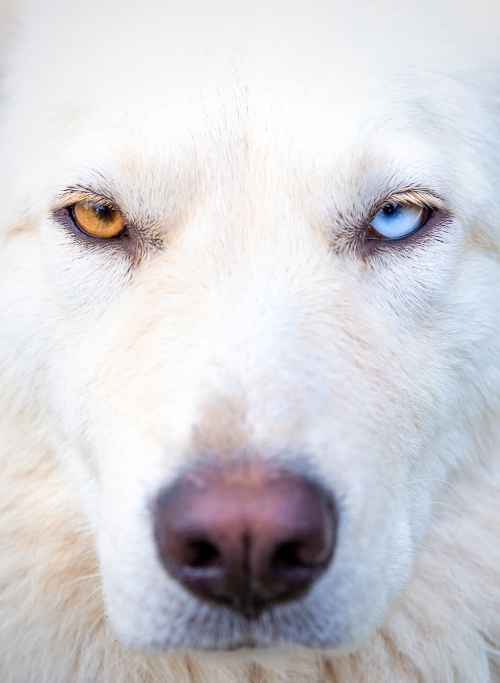Are you wondering why your dog has different-colored eyes? Well, your dog’s interesting eyes are the result of a medical condition. This condition is common amongst dogs, cats, and even humans.
This article will discuss this condition, how it affects the dog, its myths, and finally, which breeds are most prone to being born with it.
Table of Contents
What Is Heterochromia In Dogs?
Heterochromia is a condition where one or both eyes of your dog are different in colors to one another. It is a common condition that affects specific breeds such as Dalmatians, Border Collies, and Siberian Huskies, to name a few.

Heterochromia can be caused by either genetics, where they inherit it from their parents, or it can be induced from an injury to the eye. Hereditary Heterochromia is most common among some dog breeds, whereas injury-induced Heterochromia is less common however requires immediate attention.
Apart from hereditary and injury, another cause of Heterochromia in dogs is diseases. Immediate attention is needed if you notice your dog’s eyes begin to change colors.
Dog With Different Colored Eyes Myth
There have been many myths associated with Heterochromia. Native Americans, for example, believed that one blue and one brown/amber eye allowed the dog to see the heavens and earth simultaneously.
Other myths around Heterochromia claim that dogs with red or brown eyes are spirit dogs and natural-born protectors. In contrast, others claim that sled dogs with Heterochromia are much faster than those with dual-colored eyes.
These myths and legends are unlikely to be true; however, they are great stories to listen to. Some of these myths include:
Dogs With Heterochromia Are Deaf
Heterochromia in dogs has been associated with deafness; however, there is insufficient evidence to prove this.
Researchers have, however, noticed that dogs with pigmented patterns on their white coats and merle coats are more prone to developing other medical conditions like blindness alongside Heterochromia.
Dogs With Heterochromia Are Blind
Dogs with Heterochromia can sometimes get blind. This is a false myth because Heterochromia is associated with the differing iris color.

Pigmentary glaucoma could be a condition that may affect your dog’s vision. This is where your dog’s eyes will be sensitive to light. The retina and optic nerve are what control vision, so if they are not affected, then there would be no blindness.
In Dogs, Heterochromia Is Only Observed In Eyes
Heterochromia is a condition that affects your dog’s eyes, specifically the iris. Brown eyes are the common and natural color for dog eyes; however, a dog with Heterochromia has blue or light blue-whitish eyes caused by a lack of melanin.
Occasionally injury can be a cause for Heterochromia; however, such cases are few.
Illness Causes Heterochromia In Dogs
Although Heterochromia has been caused by some diseases and illnesses like diabetes, most cases are caused by genetic makeup. This means that most dog breeds often get Heterochromia because it is in their genes and passed down to them from their parents.
Heterochromia Is Painful For Dogs
This is a false myth because there is no pain associated with Heterochromia. Heterochromia is a condition where the two eye colors differ because one has less melanin than the other.
The iris is just another color because of the lack of melanin. Therefore, there is no pain unless the cause of the Heterochromia in your dog was due to an eye injury or other underlying health conditions.
In such cases, the pain that your dog would be experiencing would be associated with the injury or primary condition and not Heterochromia.
A Dog With Heterochromia Have Suffered An Eye Injury
There is some truth to this myth; eye injuries are associated with Heterochromia.
Many cases of Heterochromia are inherited from birth; however, if you gradually notice a change in the color of your dog’s pupil, then a visit to the veterinarian should be scheduled.
This can indicate that your dog has suffered trauma to their eye, or it could be that your dog has another underlying condition. Not all Heterochromia is caused by eye injuries; a majority of the time, it is inherited.
Heterochromia Is A Genetic Problem
This myth has some truth to it. Some dog breeds like Dalmatians are prone to getting Heterochromia through their genes. This type of Heterochromia does not affect your dog negatively, and frequently owners ignore it.
Dogs that have white coats or patterns on their coats are also most likely to have Heterochromia, and again this does not pose any threat or health conditions of any sort.
What Causes Heterochromia In Dogs?
One of the primary causes of Heterochromia in dogs is the lack of melanin in one or both eyes. This makes the eye appear blue/white. Another cause of Heterochromia in dogs maybe because they inherited it from birth, meaning that it is in their genetics and often is of no concern.
Your dog’s eye color can also change due to health conditions and eye injuries. Make sure to take your dog to the veterinarian for a check-up.
Types Of Heterochromia In Dogs
Heterochromia in dogs come in three forms, which are:
- Complete Heterochromia – This is when one of your dog’s iris is completely a different color compared to the other iris.
- Partial Heterochromia – Only a minor part of the iris in either one or both eyes will have a different color.
- Central Heterochromia – This is when the differing color starts from the border between the iris and pupil. The center of the iris will radiate a differing color.
Can A Dog With Heterochromia Have Health Problems?
There is insufficient evidence to prove that dogs with Heterochromia have health problems. It is commonly believed that dogs who inherit Heterochromia through birth are prone to health conditions that affect their hearing and vision.
However, these are not true because, in most cases, their vision and hearing are normal. The only difference setting them apart from other dogs is the lack of melanin in the iris.
If you notice your dog’s eyes start to change suddenly, you should take them to get a check-up. Heterochromia can also be caused by an eye injury which could possibly lead to their vision being impaired.
Heterochromia, in most cases, is something not to be concerned about, especially if it is inherited. The eye is only a different color because there is less melanin in it.
List Of Dog Breeds With Different Colored Eyes
Heterochromia and how it manifests within dogs appear to correlate to your dog’s type of coat pattern directly. It has been identified in many dogs with white or merle coloring around the head.

Australian Cattle Dogs and Siberian Huskies are two breeds that are most prone to getting Heterochromia. Other dog breeds that are prone to Heterochromia include:
- Australian cattle dogs
- Chihuahuas
- Dachshunds
- Great Danes
- Shetland sheepdogs
- Shih Tzu
- Siberian huskies
FAQ
White Dog With Different Colored Eyes?
Dogs with White coats have been identified as being most prone to getting Heterochromia. Alaskan Malamute is an example where one or both of the iris differs in color. This is a genetic trait and is often harmless to them.
What Does It Mean When A Dog Has Two Different Colored Eyes?
This means that your dog has Heterochromia, a condition where eye colors differ. It is important to know the cause of the change in eye color as Heterochromia can either be hereditary or caused by an eye injury.
What Is The Rarest Color Of Eyes For Dogs?
Green eyes are the rarest color a dog can have. The most common eye colors for dogs with Heterochromia are blue, light blue, and whitish-grey. Green-eyed dogs have the merle gene, which all affects their coat. Green eyes occur through rare genetic luck.
How Common Is It To Have 2 Different Colored Eyes?
Quite common. Certain breeds of dogs such as Border Collies and Huskies are prone to Heterochromia. This is where the entire iris or parts of it are a different color to the other eye. Heterochromia is common because it is hereditary and most common among white-coated dogs.
Conclusion
Heterochromia is common among dog breeds with white or spotted coats, such as Dalmatians, Australian cattle dogs, Border Collies and Huskies.
Heterochromia affects the iris whereby the entire or part of the iris is a different color. It is either caused by inheritance, passed down through parental genes, or caused by injury or disease.
Hereditary Heterochromia is not something owners should be worried about because there is no pain involved. However, Heterochromia caused by an underlying disease or an injury is a cause for concern because an injury to the eye can be fatal.
If you notice that your dog’s eyes are changing, take them to the nearest veterinarian for a check-up.
So, that was it for the topic “Dog with different colored eyes myth,” I hope that I’ve covered all your doubts regarding this topic; if you still have any queries regarding this topic, you can let me know in the comments.


